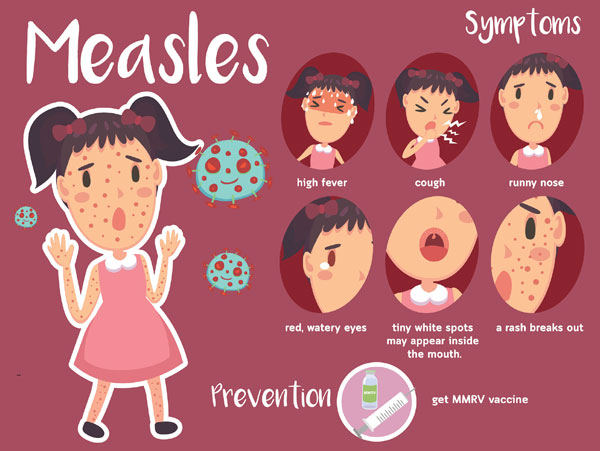Guide I-113
Revised by Sonja Koukel
College of Agricultural, Consumer and Environmental Sciences, New Mexico State University
Author: Professor/Extension Community and Environmental Health Specialist, Department of Extension Family and Consumer Sciences, New Mexico State University. (Print Friendly PDF)
In May 2019, the Centers for Disease Control and Prevention (CDC) confirmed 839 individual cases of measles in the U.S. This is the largest number of cases reported since 1994. Measles (Rubeola) in the U.S. was declared eliminated in 2000. Yet measles is on the rise and continues to spread. This guide provides information on measles and ways to protect you and your family.

© Milkos | Dreamstime.com
Most Important! Protect Your Children With Vaccination
The best way to protect against measles is to get the measles vaccine. The vaccine is usually combined with vaccines for mumps and rubella, and is known as the MMR vaccine (Figure 1).

© Felipe Caparros | Dreamstime.com
Figure 1. The measles vaccine is normally combined with vaccines for mumps and rubella, and is known as the MMR vaccine.
There are worries that the vaccine is linked to autism in children. Extensive research by the Institute of Medicine, the American Academy of Pediatrics, and the CDC has shown NO LINK to autism. Your child is at a greater risk of measles-related complications—including death—when they are not protected against this disease.
Vaccines for Children
The MMR vaccine is given in two doses:
- First dose at 12 through 15 months of age.
- Second dose at 4 through 6 years of age.
Vaccines for Adults
Teens and adults should be up to date on their MMR vaccination. Individuals should check with their healthcare provider to ask about getting the shot if they
- do not have health records showing the vaccination was given, or
- do not have proof of immunity, such as a blood test.
Why is There a Measles Outbreak?
- The majority of people who come down with measles are not vaccinated.
- Measles is still common in many parts of the world. This includes some countries in Europe, Asia, the Pacific, and Africa.
- Travelers with measles continue to bring the disease into the U.S.
- Measles spreads quickly in a community where groups of people are not vaccinated.
How Easy is it to Get Measles?
Measles is caused by a virus. It is contagious, or easily spread, through the air. It is so contagious that if one person has it, up to 90% of the people around them will become infected if they have not been vaccinated. An infected person can spread measles to others before knowing THEY have the disease.
The virus is found in the mucus (fluid) of the nose and throat. Droplets of mucus containing the virus are released into the air through coughing, sneezing, or talking. The droplets can land on surfaces where the virus can remain alive for several hours. Long after an infected person has left the area, you can catch measles by touching contaminated objects and then touching your eyes, nose, or mouth.
How do I Know if I Have Measles?
If you are exposed to measles, you may experience any or all of these signs (Figure 2).

© Tulakarn Tuangsitthisombat | Dreamstime.com
Figure 2. Measles causes a variety of symptoms, including fever, cough, runny nose, pinkeye, Koplik’s spots, and an itchy rash.
Any time between 10 to 12 days after exposure to the virus:
- Fever
- Coughing
- Runny nose
- Pinkeye, when the whites of your eyes appear reddish or pink due to swelling (inflammation) or infection.
- Sore throat
Sometime between 12 to 15 days after exposure to the virus:
- White spots appear in the mouth. Known as Koplik’s spots, this is a well-known sign of the disease.
- Following the appearance of Koplik’s spots, a person’s fever can rise suddenly and rapidly up to 105°F.
- A blotchy, mildly itchy red rash appears on the face and rapidly spreads downward to other parts of the body.
Measles is contagious four (4) days before the rash begins. It remains contagious for four (4) days after the rash is gone.
How Serious is Measles?
Up to 20% of people who come down with measles suffer complications, including the following:
- Ear infection—Can lead to permanent hearing loss.
- Bronchitis—This is swelling (inflammation) of the lining of bronchial tubes. Bronchial tubes carry air to and from the lungs. Bronchitis causes coughing and spasms (a sudden tightening of the muscle).
- Pneumonia—An infection of the lung(s).
- Laryngitis—Inflammation in the throat that often causes a person to lose their voice and not be able to talk normally.
- Encephalitis—Swelling of the brain that can lead to muscle spasms, coma, permanent brain damage, or death. A coma is when a person falls into a deep level of unconsciousness (being unaware) for long periods of time.
In pregnant women, measles can cause a miscarriage (lose the baby) or cause the baby to be born early (premature).
Important: The regular measles virus is not linked to birth defects
Children and adults who do not get the measles vaccine and come down with the virus put others in their community at risk of getting the disease. Communities require high levels of MMR-vaccinated people to prevent outbreaks.
References
Centers for Disease Control and Prevention (CDC). 2019, March 28. Measles, mumps, and rubella (MMR) vaccination: What everyone should know. Retrieved from https://www.cdc.gov/vaccines/vpd/mmr/public/index.html
CDC. 2020, November 5. Top 4 things parents need to know about measles. Retrieved from https://www.cdc.gov/measles/about/parents-top4.html
CDC. 2020, November 5. Vaccine for measles. Retrieved from https://www.cdc.gov/Features/Measles/
CDC. 2020, November 5. Complications of measles. Retrieved from https://www.cdc.gov/measles/symptoms/complications.html
For Further Reading
I-102: West Nile Virus: Information for New Mexicans
https://pubs.nmsu.edu/_i/I102/
I-108: Recommended Vaccinations for Adults
https://pubs.nmsu.edu/_i/I108/
I-114: Choosing Non-prescription and Over-the-counter Drugs
https://pubs.nmsu.edu/_i/I114/

Sonja Koukel is a Professor and Extension Community and Environmental Health Specialist in the Department of Extension Family and Consumer Sciences. She earned her B.S. at NMSU and her M.S. and Ph.D. at Texas Tech University. Her Extension programs focus on health and wellness—physical, mental, spiritual, and environmental.
To find more resources for your business, home, or family, visit the College of Agricultural, Consumer and Environmental Sciences on the World Wide Web at pubs.nmsu.edu.
Contents of publications may be freely reproduced, with an appropriate citation, for educational purposes. All other rights reserved. For permission to use publications for other purposes, contact pubs@nmsu.edu or the authors listed on the publication.
New Mexico State University is an equal opportunity/affirmative action employer and educator. NMSU and the U.S. Department of Agriculture cooperating.
Revised December 2021 Las Cruces, NM


